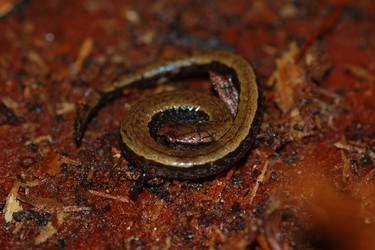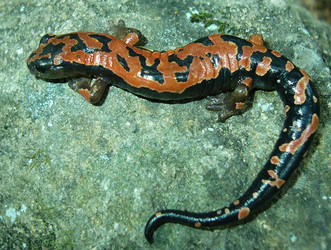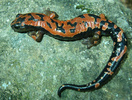Bolitoglossinae
David Wake and Tom Devitt


This tree diagram shows the relationships between several groups of organisms.
The root of the current tree connects the organisms featured in this tree to their containing group and the rest of the Tree of Life. The basal branching point in the tree represents the ancestor of the other groups in the tree. This ancestor diversified over time into several descendent subgroups, which are represented as internal nodes and terminal taxa to the right.

You can click on the root to travel down the Tree of Life all the way to the root of all Life, and you can click on the names of descendent subgroups to travel up the Tree of Life all the way to individual species.
For more information on ToL tree formatting, please see Interpreting the Tree or Classification. To learn more about phylogenetic trees, please visit our Phylogenetic Biology pages.
close boxThe subfamily Bolitoglossinae (sensu Chippindale et al., 2004) comprises two supergenera: Batrachoseps (one genus, Batrachoseps) and Bolitoglossa (comprising 13 genera - Bolitoglossa, Bradytriton, Chiropterotriton, Cryptotriton, Dendrotriton, Ixalotriton, Lineatriton, Nototriton, Nyctanolis, Oedipina, Parvimolge, Pseudoeurycea, and Thorius).
Introduction
Members of the subfamily Bolitoglossinae occur in western North America, Central America and South America. All of the tropical representatives are included within a single clade (supergenus Bolitoglossa) that has undergone an extensive evolutionary radiation in the New World tropics, including highly arboreal and fossorial groups (Wake and Lynch, 1976). Convergent and parallel evolutionary origins of webbing of the feet are observed in several genera, with the most extensive webbing found in arboreal and semiarboreal members of the genus Bolitoglossa (Wake and Lynch, 1976; Alberch, 1981; Wake, 1991; Parra-Olea et al., 2004). Convergent and parallel evolutionary trends are observed also for elongate, fossorial forms among the tropical genera Lineatriton and Oedipina and the temperate supergenus Batrachoseps (Parra-Olea and Wake, 2001).
The supergenus Bolitoglossa contains about two-thirds of plethodontid species and 40% of all species of salamanders. The genus Bolitoglossa represents the largest and most widely distributed genus of salamander, with over 90 species, or about 17% of all recognized salamander species (AmphibiaWeb: Amphibian Facts). The supergenus Batrachoseps is comprised of a single genus (Batrachoseps) with two subgenera recognized, Batrachoseps and Plethopsis, which are restricted to the west coast of North America.
Characteristics
Diagnosis
A unique synapomorphy of Batrachoseps , Bolitoglossa is loss of one pair of chromosomes (N=13).
Detailed Characteristics of the Subfamily Bolitoglossinae
Morphological characteristics detailed below are summarized from Lombard and Wake's (1986) phylogenetic analysis of major plethodontid lineages with special emphasis on evolution of feeding mechanisms. These characteristics are useful in combination for distinguishing bolitoglossine salamanders from other plethodontids, although the characteristics listed are not synapomorphies of the subfamily Bolitoglossinae.
Tongue and Hyobranchial Apparatus
All bolitoglossines have attached projectile (Batrachoseps) or freely projectile tongues (i.e., lack the genioglossus muscle and anterior connective tissue; Lombard and Wake, 1986). The hyobranchial skeleton lacks a urohyal, has an expanded basibranchial, and radii that are closely attached to and continuous with the basibranchial. The epibranchial is relatively longer than the basibranchial and first ceratobranchial. The second ceratobranchial is larger in diameter than the first ceratobranchial and constitutes the primary force-transmitting element in the movement of the tongue. The rectus cervicis profundis muscle is folded dorsally near its anterior end. The slip in the rectus cervicis superficialis has been lost. The omohydoideus, genioglossus, and circumglossus have been lost. The intraglossus is attached to the anterior end of basibranchial, lingual cartilage, or equivalent, or to the anterior end of the glossal ligament, ventral to the basibranchial. The basiradialis muscle may be present or absent. The hyoglossus muscle has a complete anterior section and posteriorly-oriented fibers in the posterior section. The suprapeduncularis muscle is present. The ramus hypoglossus bifurcates posteriorly, between the attachment of the first ceratobranchial to the basibranchial and to the epibranchial.
Epibranchial Number
Embryos have a single epibranchial.
Tail Autotomy
Cutaneous wound healing in the tail occurs, there are 2 caudosacral vertebrae, the first caudal vertebra is specialized, and tail breakage is localized.
Brain Stem Motor Column
There is only one class of brain stem motor column cells.
Jaws, Cranial Osteology and Structure of the Inner Ear
The bony shelf of the preorbital process is absent. A distinct lateral spur on the parietal is present. Premaxillary bones are relatively slender, and the intermaxillary gland is posterior to the pars dentalis. The periotic canal is straight or with a dorsal loop after it leaves the periotic cistern. Growth of otic semicircular ducts is nearly isometric.
Chromosome Number
The diploid number of chromosomes is 26.
Development
Development is direct.
Classification
Traditionally, Plethdontidae was subdivided into two subfamilies, Desmognathinae and Plethodontinae, the latter of which was further subdivided into the tribes Bolitoglossini, Hemidactyliini and Plethodontini (Wake, 1966; Lombard and Wake, 1986). More recent phylogenetic analyses of whole mitochondrial genomic DNA sequences (Mueller et al., 2004; Macey, 2005) and combined mitochondrial DNA, nuclear DNA and morphology (Chippindale et al., 2004) reject the monophyly of these traditional groupings. Consistent with their phylogeny, Chippindale et al. (2004) recommended several taxonomic changes that required minimal changes to traditional taxonomic arrangements, including elevating the tribe Bolitoglossini to the subfamily Bolitoglossinae.
Discussion of Phylogenetic Relationships
Lombard and Wake (1986) postulated a sister-group relationship between Batrachoseps and the supergenus Bolitoglossa based on 30 morphological characters with an emphasis on the hyobranchial skeleton and musculature of the feeding system. Subsequent phylogenetic analyses of combined mitochondrial DNA and morphology (Jackman et al., 1997) and combined mitochondrial DNA, nuclear DNA and morphology support this relationship (Chippindale et al., 2004). In contrast, Bayesian and maximum likelihood analysis of whole mitochondrial genomic DNA sequences recovered a sister-group relationship between Batrachoseps and Hemidactylium scutatum, while parsimony analysis placed Hemidactylium basal to all other plethodontids (Mueller et al., 2004; Macey, 2005).
References
Alberch, P. 1981. Convergence and parallelism in foot evolution in the neotropical salamander genus Bolitoglossa, I. Function. Evolution 35:84-100.
Chippindale, P. T., R. M. Bonett, A. S. Baldwin, and J. J. Wiens. 2004. Phylogenetic evidence for a major reversal of life-history evolution in plethodontid salamanders. Evolution 58:2809-2822.
Garcia-Paris, G., D. A., Parra-Olea, G., and Wake, D. B. 2000. Biodiversity of Costa Rican salamanders: implications of high levels of genetic differentiation and phylogeographic structure for species formation. Proceedings of the National Academy of Sciences USA 97:1640-1647.
Jackman, T., G. Applebaum, and D. Wake. 1997. Phylogenetic relationships of bolitoglossine salamanders: a demonstration of the effects of combining morphological and molecular data sets. Molecular Biology and Evolution 14:883-891.
Lombard, R. E. and D. B. Wake. 1986. Tongue evolution in the lungless salamanders, family Plethodontidae. IV. Phylogeny of plethodontid salamanders and the evolution of feeding dynamics. Systematic Zoology 35:532-551.
Macey, J. R. 2005. Plethodontid salamander mitochondrial genomics: A parsimony evaluation of character conflict and implications for historical biogeography. Cladistics 21:194-202.
Mueller, R. L., J. R. Macey, M. Jaekel, D. B. Wake, and J. L. Boore. 2004. Morphological homoplasy, life history evolution, and historical biogeography of plethodontid salamanders inferred from complete mitochondrial genomes. Proceedings of the National Academy of Sciences USA 101:13820-13825.
Parra-Olea, G., and D. B. Wake. 2001. Extreme morphological and ecological homoplasy in tropical salamanders. Proceedings of the National Academy of Sciences USA 98:7888-7891.
Parra-Olea, G., M. Garcia-Paris, and D. B. Wake. 2002. Phylogenetic relationships among the salamanders of the Bolitoglossa macrinii species group (Amphibia: Plethodontidae), with descriptions of two new species from Oaxaca (México). Journal of Herpetology 36:356-366.
Parra-Olea, G., M. Garcia-Paris, and D. B. Wake. 2004. Molecular diversification of salamanders of the tropical American genus Bolitoglossa (Caudata: Plethodontidae) and its evolutionary and biogegraphical implications. Biological Journal of the Linnean Society 81:325-346.
Wake, D. B. 1966. Comparative osteology and evolution of the lungless salamanders, family Plethodontidae. Memoirs of the Southern California Academy of Sciences 4:1-111.
Wake, D. B. 1991. Homoplasy: the result of natural selection, or evidence of design limitations? American Naturalist 138:543-567.
Wake, D. B., and P. Elias. 1983. New genera and a new species of Central American salamanders, with a review of the tropical genera (Amphibia, Caudata, Plethodontidae). Contributions in Science, Natural History Museum of Los Angeles County 345:1-19.
Wake, D. B. and J. F. Lynch. 1976. The distribution, ecology and evolutionary history of plethodontid salamanders in tropical America. Natural History Museum of Los Angeles County Science Bulletin 25:1-65.
Title Illustrations

| Scientific Name | Batrachoseps attenuatus |
|---|---|
| Location | discovered under a log, western Humboldt County, California |
| Specimen Condition | Live Specimen |
| Behavior | defensive posture |
| Source | Batrachoseps attenuatus |
| Source Collection | Flickr |
| Copyright | © 2007 squamatologist |
About This Page
David Wake

University of California, Berkeley, California, USA
Tom Devitt

University of California, Berkeley, California, USA
Correspondence regarding this page should be directed to David Wake at
Page copyright © 2006 David Wake and
All Rights Reserved.
- First online 27 September 2006
- Content changed 27 September 2006
Citing this page:
Wake, David and Tom Devitt. 2006. Bolitoglossinae. Version 27 September 2006 (under construction). http://tolweb.org/Bolitoglossinae/15532/2006.09.27 in The Tree of Life Web Project, http://tolweb.org/









 Go to quick links
Go to quick search
Go to navigation for this section of the ToL site
Go to detailed links for the ToL site
Go to quick links
Go to quick search
Go to navigation for this section of the ToL site
Go to detailed links for the ToL site